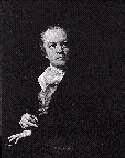William Blake's Profile

William Blake was born in London, England on November 28, 1757, the third son of James Blake, a London hosier, and his mother Catherine Harmitage. His eldest brother gained control over his father's hosiery business. His younger brothers were smitten with tragedy. The youngest brother, Robert, who tended to be more favored by William, because he also had artistic abilities, died of comsumption at the age of 21. Another brother, Richard, died in infancy. Largely self-taught, Blake began writing poetry when he was twevle years old, and by the age of ten was sent to study at Henry Par's drawing school on The Strand. At ofurteen he was apprenticed to the master engraver James Basire. For the next seven years, he learned the fine arts of engraving, etching, stippling and copying. After his apprenticeship had been completed, he set out at 21 to earn his living as a professional engraver. Two years later, he met his future wife, Catherine Boucher, who was the illiterate daughter of a Battersea market-gardener. They married on August 18, 1782. She learned to paint and draw, but remained illiterate, and childless until her death in 1831. In 1783, he published his first volume of poetry, Poetical Sketches, for his friends. The next year, he started a print shop with a former fellow apprentice, but it soon failed. From the years 1793 to 1800, his creative output was greater than ever. Unfortunately, this great exertion seemed to have worn Blake out. Following numerous dissapointments, both in the recognition of his literary and artistic works, he entered into a stage of depression. This period, in which even some of his close friends and acquaintances deemed him insane, lasted from 1810 to 1817. At twenty he claimed to be haunted by visions, and saw the ghosts of the departed wandering the streets. In 1818 Blake seemed to be regaining is happiness. He was finally be recognized for his many works of art, and became close with many English artist. However, in 1824, he began to suffer with frmo the early symptoms of gallstones, which eventually led to his death on August 12, 1927. He was buried in a common grave.
|